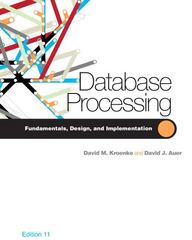Question
1 Task We will study the dataset called nycflights13. It gives information about all 336,776 flights that departed in 2013 from the three New York
1 Task We will study the dataset called nycflights13. It gives information about all 336,776 flights that departed in 2013 from the three New York (in the US) airports (EWR, JFK, and LGA) to destinations in the United States, Puerto Rico, and the American Virgin Islands. Download the following data files from our unit site (Learning Resources Data): nycflights13_flights.csv.gz flights information, nycflights13_airlines.csv.gz decodes two letter carrier codes, nycflights13_airports.csv.gz airport data, nycflights13_planes.csv.gz plane data, nycflights13_weather.csv.gz hourly meteorological data for LGA, JFK, and EWR. Refer to the comment lines in the CSV files (note that they are gzipped) for more details about each column. Just like in the 6th part of Module 4 (4.6. Database Access), our aim is to use pandas to come up with results equivalent to those that correspond to example SQL queries. Create a single Jupyter/IPython notebook (see the Artefacts section below for all the requirements), where you perform what follows. 1. Establish a connection with a new SQLite database on your disk. 2. Export all the CSV files to the said database. 3. For each of the SQL queries below (each query in a separate section), write the code that yields equivalent results using pandas only and explain in your own words what it does. task1_sql = pd.read_sql_query(""" ...an SQL statement... 1 """, conn) task1_my = ( ...your solution using pandas... without SQL ) pd.testing.assert_frame_equal(task1_sql, task1_my) # we expect no error here Important. Sometimes, the results generated by pandas will be the same up to the reordering of rows. In such a case, before calling assert_frame_equal, we should sort_values on both data frames to sort them with respect to 1 or 2 chosen columns. Here are the SQL queries: 1. SELECT DISTINCT engine FROM planes 2. SELECT DISTINCT type, engine FROM planes 3. SELECT COUNT(*), engine FROM planes GROUP BY engine 4. SELECT COUNT(*), engine, type FROM planes GROUP BY engine, type 5. SELECT MIN(year), AVG(year), MAX(year), engine, manufacturer FROM planes GROUP BY engine, manufacturer 6. SELECT * FROM planes WHERE speed IS NOT NULL 7. SELECT tailnum FROM planes WHERE seats BETWEEN 150 AND 190 AND year >= 2012 8. SELECT tailnum, manufacturer, seats FROM planes WHERE manufacturer IN ("BOEING", "AIRBUS", "EMBRAER") AND seats>390 9. SELECT DISTINCT year, seats FROM planes WHERE year >= 2012 ORDER BY year ASC, seats DESC 10. SELECT DISTINCT year, seats FROM planes WHERE year >= 2012 ORDER BY seats DESC, year ASC 11. SELECT manufacturer, COUNT(*) FROM planes WHERE seats > 200 GROUP BY manufacturer 12. SELECT manufacturer, COUNT(*) FROM planes GROUP BY manufacturer HAVING COUNT(*) > 10 13. SELECT manufacturer, COUNT(*) FROM planes WHERE seats > 200 GROUP BY manufacturer HAVING COUNT(*) > 10 14. SELECT manufacturer, COUNT(*) AS howmany FROM planes 2 GROUP BY manufacturer ORDER BY howmany DESC LIMIT 5 15. SELECT flights.*, planes.year AS plane_year, planes.speed AS plane_speed, planes.seats AS plane_seats FROM flights LEFT JOIN planes ON flights.tailnum=planes.tailnum 16. SELECT planes.*, airlines.* FROM (SELECT DISTINCT carrier, tailnum FROM flights) AS cartail INNER JOIN planes ON cartail.tailnum=planes.tailnum INNER JOIN airlines ON cartail.carrier=airlines.carrier 17. SELECT flights2.*, atemp, ahumid FROM ( SELECT * FROM flights WHERE origin='EWR' ) AS flights2 LEFT JOIN ( SELECT year, month, day, AVG(temp) AS atemp, AVG(humid) AS ahumid FROM weather WHERE origin='EWR' GROUP BY year, month, day ) AS weather2 ON flights2.year=weather2.year AND flights2.month=weather2.month AND flights2.day=weather2.day Do not include full outputs of the SQL queries in the report
Step by Step Solution
There are 3 Steps involved in it
Step: 1

Get Instant Access to Expert-Tailored Solutions
See step-by-step solutions with expert insights and AI powered tools for academic success
Step: 2

Step: 3

Ace Your Homework with AI
Get the answers you need in no time with our AI-driven, step-by-step assistance
Get Started


